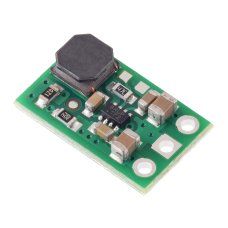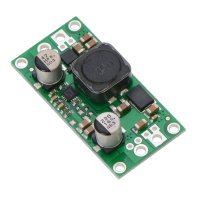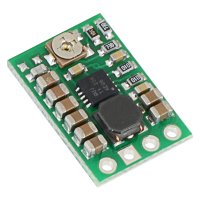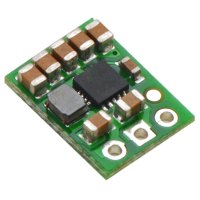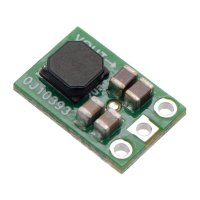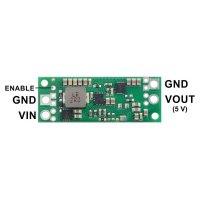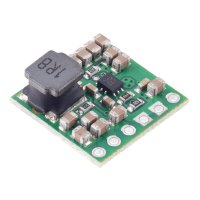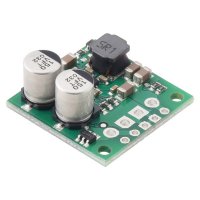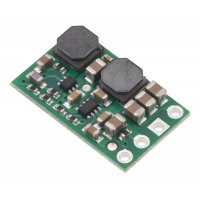- The regulators actively limit the instantaneous input currents to 2 A when boosting, and input currents up to around 1.6 A can typically be maintained for many minutes without triggering thermal shutdown, though the actual performance depends on the input and output voltages as well as external factors such as ambient temperature and airflow. For boost regulators, the output current equals the input current times the efficiency divided by the boost ratio of VOUT to VIN, so the more you are boosting, the lower the maximum output current will be (see the maximum continuous output current section below for performance graphs).
- These regulators feature a variety of built-in protections, including cycle-by-cycle input current limiting, under-voltage lockout, and over-temperature shutdown.
- This boost regulator uses the typical topology that connects the input to the output through an inductor and diode, with nothing to completely break that current path. Therefore, the input voltage will go through to the output even when the regulator is disabled, and exposure to short circuits or other excessive loads will damage the regulator. This regulator also does not have protection against reverse voltage.
- The U3V16x family includes seven versions with fixed output voltages ranging from 3.3 V to 15 V.
- U3V16F3: Fixed 3.3V output
- U3V16F5: Fixed 5V output
- U3V16F6: Fixed 6V output
- U3V16F7: Fixed 7.5V output
- U3V16F9: Fixed 9V output
- U3V16F12: Fixed 12V output
- U3V16F15: Fixed 15V output
- Output voltage: 3.3V/5V/6V/7.5V/9V/12V with 4% accuracy
- Input voltage: 1.3 V to 16 V (Note: minimum start-up voltage is 2.7 V)
- Typical efficiency of 85% to 95%, depending on input voltage, output voltage, and load (see the efficiency graph below)
- Switching frequency: ~1.2 MHz under heavy loads
- Power-save mode that increases light load efficiency by reducing switching frequency
- Typical no-load quiescent currents under 1 mA (see the quiescent current graph below)
- 2 A switch current limit
- Typical continuous input currents up to around 1.6 A (see the maximum continuous output current graph below)
- Tolerates input voltage above output set voltage (output will track input, see the connections section for details)
- Integrated protections:
- Over-temperature shutdown
- Soft-start feature limits inrush current and gradually ramps output voltage
- Under-voltage lockout
- Compact size: 0.515″ × 0.32″ × 0.1″ (13.1 × 8.1 × 3 mm)
- Weight: 0.4 g

- VOUT is the regulated output voltage. The regulator’s soft-start feature gradually ramps up the VOUT voltage on start-up to limit in-rush current draw. The U3V16Fx regulators do not have short-circuit protection, so they could be damaged if exposed to output shorts or excessive loads.
- The connections are labeled on the back side of the PCB and are arranged with a 0.1″ spacing along the edge of the board for compatibility with solderless breadboards, connectors, and other prototyping arrangements that use a 0.1″ grid. You can solder wires directly to the board or solder in either the 1×3 straight male header strip or the 1×3 right-angle male header strip that are included.
Typical efficiency:
- 1 x Pololu 4940/4941/4942/4943/4944/4945/4946 3.3V/5V/6V/7.5V/9V/12V Step-Up Voltage Regulator U3V16F3/5/6/7/9/12/15
Pololu 4940/4941/4942/4943/4944/4945/4946 Step-Up Voltage Regulator U3V16F3/5/6/7/9/12/15
- Brand: Pololu
- Product Code: NR-Pololu-Step-Up-Voltage-Regulator
- Reward Points: 4
- Availability: In Stock
- रo 470.00
-
रo 451.00
- Price in reward points: 470
-
- 25 or more रo 449.00
- 63 or more रo 445.00
- 96 or more रo 429.00
- 250 or more रo 414.00
Available Options
Related Products
Pololu 2574/2575/2576/2577/2572/2573 5V/ 6V/ 9V/ 12V/ 4-12V/ 9-30V Step-Up/Step-Down Voltage Regulator S18V20F5/ 6/ 9/ 12/ ALV/ AHV
This powerful S18V20F5 S18V20F6 S18V20F9 S18V20F12 step-up/step-down regulator efficiently produces ..
रo 2,092.00 रo 2,179.00
Pololu 2122 3.3V Step-Up/Step-Down Voltage Regulator S7V8F3
The S7V8F3 switching step-up/step-down regulator efficiently produces a fixed 3.3 V output from inpu..
रo 602.00 रo 628.00
Pololu 2119 5V Step-Up/Step-Down Voltage Regulator S7V7F5
The S7V7F5 switching step-up/step-down regulator efficiently produces 5 V from input voltages betwee..
रo 527.00 रo 549.00
Pololu 2836 5V Step-Up/Step-Down Voltage Regulator S9V11F5
The S9V11F5 switching step-up/step-down regulator efficiently produces 5 V from input voltages betwe..
रo 679.00 रo 707.00
Pololu 2890/2891/2892/2893/2894/2895/2896 5V/ 6V/ 7.5V/ 9V/ 12V/ 15V/ (Adjustable 4.5-20V)Step-Up Voltage Regulator
This powerful synchronous switching boost regulator efficiently generates an output voltage of 5 V, ..
रo 1,361.00 रo 1,417.00
Pololu 4012 / 4013 / 4014 / 4015 / 4016 Step-Up Voltage Regulator
The U3V40Fx family of boost (step-up) voltage regulators are high-efficiency synchronous switching r..
रo 754.00 रo 786.00
Pololu 4980/4981/4982/4983/4984/4985 3.3V/6V/7.5V/9V/12V/15V 2.5A Step-Up/Step-Down Voltage Regulator S13V25F3/F6/F7/F9/F12/F15
This synchronous switching step-up/step-down regulator efficiently produces 3.3 V / 6 V / 7.5 ..
रo 1,057.00 रo 1,101.00
Pololu 4964/4965/4966/4967/4968 3.3V/5V/6V/7.5V/9V Step-Up/Step-Down Voltage Regulator S8V9F3/F5/F6/F7/F9
This synchronous switching step-up/step-down regulator efficiently produces 3.3 V/ 5 V/6 V/ 7.5 V/ 3..
रo 702.00 रo 731.00

